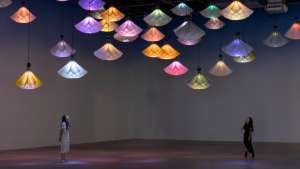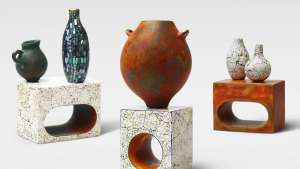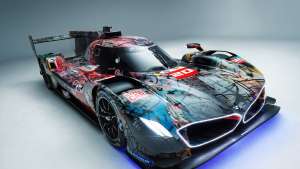Perhaps one of the most provocative thinkers when it comes to issues of anthropocentrism, gender politics and design, Taiwanese artist Kuang-Yi Ku makes us rethink our place in the natural world in darkly humorous, often transgressive ways. His work is both impressively pragmatic and able to suspend disbelief.
Born and raised in Taipei, Taiwan but currently living in the Netherlands, Ku is in the midst of his PhD research at Sheffield Hallam University in the UK on the interdisciplinary practice between art, design and bioscience. The multi-talented artist also has three master’s degrees in social design, dentistry and communication design, and co-founded TW BioArt (Taiwan Bioart Community) to encourage and stimulate fields of bio-art, science and art in Taiwan.
His most recent exhibition, ‘Queer Termite Project’, creates the prototype of a futuristic scenario in which much-maligned termites co-exist with humans.
“One of the scientists with whom I collaborated on this project is Kuan-Chih Kuan. He is also interested in sci-fi writing,” Ku says. “In this project, he finished a sci-fi novel called ‘Deep Termites’. In the story, the earth is facing the end of the world, so a group of fictional termites attempted to invite humans to join them to migrate to outer space. The imaginary termites are highly civilised and contain more than 1 000 different classes. Also, there are seven main classes that appeared in the story. In this project, I wanted to visualise and materialise this sci-fi scenario in order to allow the audience to feel and sense the speculative imagination.”
Rethinking the role of termites as ‘pests’
Perhaps the most obvious question for Ku is: why do termites hold such fascination for him?
“I have been interested in the social structure of eusocial species, such as ants, bees, and termites for quite a long time,” Ku reveals. “Last year, I was fortunate to be introduced to the Laboratory of Urban Entomology of NCHU, which specialises in termite biology. The termite scientists have told me lots of interesting stories behind their termite research. For example, termites have been recognised as pests in human history, mainly because many of our architectures or artifacts are made of wood, which is their food.”
Termites are the ‘bad guys’ in many cultural stories, while ants are symbols of hard work – but if one studies nature closely, one can flip this narrative on its head. “Termites are vegetarians who consume the fallen branches in the forest and transform the cellulose into protein, which is the energy resource in the food-chain cycle; on the other hand, ants are predators that hunt and eat termites to get energy,” Ku says.
It’s an anthropocentric view to see termites as pests, which didn’t sit well with the designer. “I started to think to construct a new story about termites from a non-anthropocentric point of view,” he explains. “In the sci-fi story of my ‘Queer Termite Project’, we construct a fictional termite community that is highly civilised – even more intelligent than human beings – and plays a ‘good’ role. The sci-fi narrative becomes even more extreme – while earth is facing the end of the world, termites invite humans to migrate to outer space and live together.”
In Ku’s story, humans become to termites what dogs or cats are to humans. The co-living space is designed by termites, and humans have only a basic living space, reflective of how we treat our pets.
“In the imaginary interspecies future, humans and termites live together, and the boundary of species is vague, ambiguous, and unstable,” Ku continues. “To me, this kind of interspecies relationship reflects the ideas of ‘queer ecology’, which proposes more diverse perspectives regarding how humans interact with non-human living things. I hope the story in ‘Queer Termite Project’ could be an example to reshape the cultural discrimination against termites and guide the audience to understand termites from a different perspective.”
Reinterpreting termite sexuality
A lot of Ku’s work focuses on biological sex, gender and reproduction. ‘Queer Termite Project’ draws attention to the eusocial nature of termite society – complex, highly organised, and determined according to reproductive abilities and biological sex.
As a gay man, I am specifically interested in the topic of gender and sexuality. That’s why many of my works are kind of related to these themes,” Ku says. “The diverse phenomena of animal sexuality have always fascinated me. As a result, I have done many projects about this.
The Tiger Penis Project, his graduation project for the Social Design Master's programme at Design Academy Eindhoven in 2018, was awarded the Gijs Bakker Award for the best project by a graduating master’s student. The project, which drew on Ku’s dentistry experience by employing orthodontic resin to create the sculptures, proposed using synthetic biology to create organs to replace the endangered animal products that are often used in traditional Chinese medicine, specifically the tiger penis.
Termite sexuality holds a different appeal for Ku.
“At the very beginning, I thought there was gender inequality among termites, since their working class is determined by their biological sex and the ability to reproduce. For example, only the queen termite can reproduce, and the worker termites and soldier termites need to serve the king and queen. However, I found that I had been wrong about termites after I conversed with termite scientists. The scientists indicated that termites are a superorganism – a group of synergistically interacting organisms of the same species. Each individual termite in the community plays a different role, and it is like different kinds of cells in our body, which take charge of different things.”
The queen termite is therefore like a combination of our brain cells and reproductive organs, while the soldier termites are like our immune system. The parts make up a high-functioning whole and it is anthropocentric to view their social structure as unequal.
“The queerness in ‘Queer Termite Project’ is therefore about how human and non-human species cross the line to live together,” Ku explains. “The queer spirit is challenging the cultural discrimination against termites and proposing a new interpretation of human-termite society. The instability, ambiguity and fluctuations within the human-termite relationship presents the core value of the discourse of queer ecology – the co-living scenario of cross-species breaks down the dualism of the human and non-human.”
Ku teases out some profound questions about the way humans choose to interact with nature. “How can we find new ways to live with it, and propose a more-than-human interspecies future?” he asks. “I wanted to explore these questions in my project.”
Building the prototype
“During the development of this project, I tried to organise a small team, and each of the team members are from different backgrounds – the graphic designer, architect, 3D animator, product designer, and so on,” Ku says. “The 3D animator constructed the 3D models of seven different classes of termites according to the story. The architect designed the co-living system between humans and termites. All of these 3D termite models and architectural models were 3D-printed for the exhibition. Finally, the graphic designer finished the book design for his sci-fi novel, which is also exhibited in the museum. This book not only consists of a sci-fi story but also several scientific articles which explain the biological knowledge of termites in sci-fi. These articles were written by a termite scientist.”
During the production of this project, Ku and the team held regular meetings with termite scientists in order to check whether the objects and images were employing the right scientific knowledge. “We wanted all the imaginative elements to be derived from hard-core science,” Ku asserts. “The process of designing is an interdisciplinary collaboration between art and science.”
The unmissable prototype, sponsored by the National Culture and Arts Foundation, was commissioned by the Jut Art Museum in Taiwan as part of their 5th Anniversary exhibition ‘LIVES: Life, Survival, Living’. The aim of this exhibition is to interrogate life in the future. Kuang-Yi Ku is one of 12 artists from Germany, Canada, the United States, the United Kingdom and Taiwan who was invited to participate in the exhibition, which runs until the end of July 2022. Find out more about it here: http://jam.jutfoundation.org.tw/en/exhibition/107/3403.
Read more:
The design squadron of the future.
Exploring Woven Cosmos, Kenyan biophilia, music’s mavericks, & our newest multimedia-ists.
Credits: Kuang-Yi Ku









